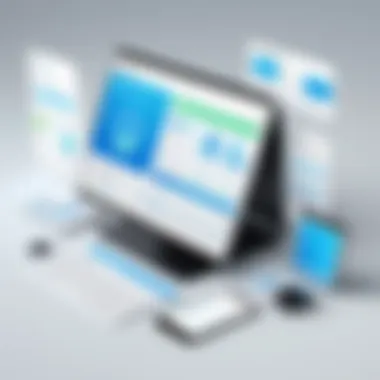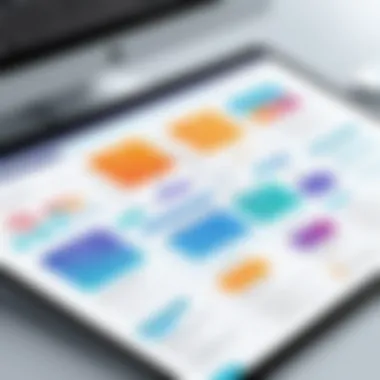Streamlining Billing: Features and Benefits Explained


Intro
An easy billing system serves as a vital component for businesses aiming to enhance financial efficiency. In a landscape where electronic transactions dominate, choosing the right billing solution can significantly impact overall productivity. This article provides an in-depth exploration of the essential aspects of an easy billing system. We will delve into its key features, benefits, and implementation strategies. Our target audience includes IT professionals, business owners, and decision-makers who seek to improve their billing processes. With practical insights, this guide aims to facilitate informed decisions about selecting a billing solution that aligns with business needs.
Key Features
Overview of Features
An easy billing system should prioritize user-friendliness while offering robust functionality. Below are some essential features that one should consider when evaluating potential solutions:
- Automated Invoicing: The system should support scheduled and automatic invoicing processes, reducing the manual workload for staff.
- Client Management: A comprehensive client management tool allows for easy storage and retrieval of customer details.
- Payment Tracking: Real-time payment tracking is crucial for monitoring transactions and managing accounts receivable efficiently.
- Integration Capabilities: The ability to integrate with existing software, such as CRM and accounting systems, enhances overall operational efficiency.
- Customizable Invoices: Easy billing solutions should provide the option to create bespoke invoices to reflect a brand’s identity.
Unique Selling Points
The unique selling points of an effective billing system often distinguish it from other solutions on the market. Key aspects might include:
- User Experience: An intuitive interface can minimize training time for employees and promote quick adaptation.
- Scalability: The system must accommodate growing businesses, allowing for the addition of features as needs evolve.
- Reliable Customer Support: Robust customer support ensures assistance during implementation and ongoing use, leading to higher satisfaction.
Pricing Structure
Tiered Pricing Plans
Many billing systems offer tiered pricing plans designed to suit businesses of different sizes. Understanding these plans can help organizations make appropriate financial decisions. Common tiers include:
- Basic Plan: Provides essential functionalities for freelancers or small businesses.
- Standard Plan: Typically includes additional features such as recurring payments and reporting tools.
- Premium Plan: Designed for larger companies with complex needs, offering extensive integrations and customization options.
Features by Plan
Analyzing features across different pricing tiers can clarify what to expect. Here are possible features one could find:
- Basic Plan: Automated invoicing, limited client management, basic reporting.
- Standard Plan: All basic features plus advanced reporting and better integration capabilities.
- Premium Plan: Comprehensive feature set, including priority support, advanced analytics, and more robust security measures.
An easy billing system can enhance cash flow management, which is vital for sustained business growth.
Understanding these aspects can lead to more informed choices regarding billing solutions that meet specific business needs. As companies navigate their unique requirements, it is essential to weigh features against pricing structures. Consider each component carefully to ensure a streamlined, efficient billing process.
Understanding Easy Billing Systems
Understanding easy billing systems is crucial for businesses that aim to enhance their operational efficiency. This section will lay the groundwork by defining what constitutes an easy billing system and discussing the significance of streamlining billing processes in today's competitive environment.
Definition of Easy Billing System
An easy billing system can be described as a software tool designed to simplify the billing and invoicing processes for businesses. It automates tasks such as generating invoices, tracking payments, and managing customer accounts. This type of system is user-friendly, ensuring that even individuals with minimal technical expertise can navigate it easily. Often, these systems come with features such as customizable templates, automated reminders, and integration with payment platforms, making them a valuable asset for companies of all sizes.
Importance of Efficient Billing Processes
Efficient billing processes are more than just a convenience; they are essential for a business's financial health. Here are several important points to consider:
- Accuracy: Efficient billing helps reduce errors that can lead to revenue loss and customer dissatisfaction.
- Time Management: Automating the billing process frees up valuable time. Employees can then focus on other tasks, improving overall productivity.
- Customer Satisfaction: Timely and precise billing enhances the customer experience. Clients are less likely to have disputes when they receive clear and accurate statements.
- Financial Management: An efficient system provides real-time insights into cash flow and receivables, aiding in strategic financial planning.
Efficient billing processes can transform how a business operates, impacting both productivity and profitability.
Essential Features of Easy Billing Systems
The essential features of easy billing systems play a crucial role in their effectiveness and user satisfaction. These features not only simplify the billing process but also enhance overall operational efficiency. As businesses evolve, the demand for streamlined financial transactions increases. A robust billing system must facilitate everything from invoicing to payment processing while maintaining user accessibility.
User-Friendly Interface
A user-friendly interface is one of the most significant aspects of an easy billing system. It allows users to navigate the software without extensive training. An intuitive design reduces errors, leading to a smoother user experience. This feature ensures that everyone in the organization, regardless of their technical expertise, can access and utilize the system effectively. When a billing system is easy to use, it encourages adoption by all team members, resulting in a more consistent and organized billing process.


Automated Invoicing
Automated invoicing is vital for reducing the time involved in billing. By generating invoices automatically based on predefined parameters, businesses can enhance efficiency. This feature also minimizes human error associated with manual entries. Automated systems can send reminders about pending invoices, which helps in maintaining timely payments. The reliance on automation fosters a culture of promptness in billing and payment processes.
Payment Integration
Payment integration is essential for offering flexibility in payment options. A billing system must support various payment methods, including credit cards, e-wallets, and bank transfers. This type of integration increases customer satisfaction as clients can select their preferred payment method. Having seamless payment integration also streamlines reconciliation processes, making it easier for businesses to track incoming payments, thus improving cash flow and bookkeeping accuracy.
Mobile Accessibility
In today’s digital world, mobile accessibility has become a key feature for billing systems. Many professionals require the ability to perform tasks on-the-go. A billing solution that offers mobile access increases the convenience factor significantly. Users can create, send, and manage invoices right from their smartphones or tablets. This flexibility allows businesses to keep processes moving swiftly, regardless of their location.
Reporting and Analytics
Reporting and analytics features are instrumental in providing insights into financial performance. An effective billing system should offer comprehensive reporting tools that help businesses analyze invoice data, payment trends, and overall financial health. These insights allow decision-makers to make informed choices, identify potential issues, and capitalize on opportunities for improvement. Access to real-time analytics is invaluable in crafting strategies aligned with financial objectives.
"A well-designed billing system can transform financial management from a hassle to a streamlined process, driving business success."
Benefits of Implementing an Easy Billing System
Implementing an easy billing system presents numerous benefits that can significantly impact the financial operations of a business. Such systems are designed to streamline the billing process, making it more efficient and user-friendly. This section outlines key advantages including time efficiency, cost savings, improved cash flow management, and enhanced customer experience. These elements are crucial for businesses looking to modernize their financial operations and respond to the growing demands of today's market.
Time Efficiency
Time efficiency is one of the most notable benefits of an easy billing system. Traditional invoicing methods can be labor-intensive. They often require manual entry, repeated tasks, and, sometimes, errors that lead to further delays. An automated billing system reduces these burdens by eliminating repetitive processes.
With features such as automatic invoicing, reminders for due payments, and integrated payment solutions, businesses can save valuable time. Team members can redirect their focus toward more strategic activities rather than getting bogged down by administrative tasks. Faster billing cycles can lead to quicker revenue collection, which is critical for sustaining a healthy business operation.
Cost Savings
Cost savings is a direct result of adopting a streamlined billing system. Traditional billing often incurs hidden costs such as paper, postage, and manual labor. These expenses can accumulate quickly and take a toll on the company’s bottom line.
In contrast, an easy billing system predominantly operates digitally. This switch can result in decreased overhead costs. Additionally, by reducing errors and inefficiencies, organizations can avoid costly mistakes associated with incorrect invoices or delayed payments. Overall, the initial investment in an electronic billing system generally leads to significant long-term savings.
Improved Cash Flow Management
Effective cash flow management is key to a business's sustainability. When billing is efficient, it directly influences the cash flow positively. An easy billing system allows businesses to track due dates meticulously and send timely reminders for payments. This proactive approach can help ensure that funds are available when needed, allowing for resource allocation and investment in growth opportunities.
Furthermore, modern systems often provide real-time insights into financial standings. This data aids in making informed decisions regarding spending and investments.
Enhanced Customer Experience
Finally, an easy billing system contributes significantly to enhanced customer experience. Customers appreciate straightforward, transparent billing processes. When invoices are clear, accurate, and sent promptly, it fosters trust and satisfaction.
Moreover, many billing systems offer multiple payment options. This flexibility allows customers to choose the option that best suits their needs, decreasing the likelihood of late payments. In essence, improving the billing experience can cultivate stronger long-term relationships between a business and its customers, ensuring loyalty and encouraging repeat transactions.
The advantages of adopting an easy billing system are not limited to the elements discussed here. They encompass a broader spectrum of improvements that, when leveraged properly, can dramatically shift a business’s financial landscape.
Considerations When Choosing a Billing System
When selecting a billing system, several key factors can significantly affect the efficiency and effectiveness of the financial operations. These considerations are crucial not only for immediate needs but also for long-term growth and adaptability. A well-chosen system supports smooth operations, minimizes errors, and enhances overall financial management. Below are the essential elements to keep in mind.
Scalability
Scalability is often overlooked but is vital in choosing a billing system. As a business grows, so do its financial requirements. A scalable billing system can accommodate increasing volumes of transactions without a complete overhaul. It’s essential to evaluate if the system can support additional features or more users as your business expands.
- Businesses should assess their projections for growth when selecting a system.
- Look for billing software that allows easy upgrades, which can ensure alignment with future business processes.
Integration Capabilities
A billing system should integrate seamlessly with other software used within an organization. This reduces data silos and improves workflow efficiency. For example, if your business uses tools like QuickBooks for accounting or Salesforce for customer relationship management, compatibility matters. An integrated system allows for real-time data sharing, reducing the need for manual data entry, which can lead to errors.


Consider the following when evaluating integration:
- API Availability: A strong API allows third-party applications to connect easily.
- Common Platforms: Ensure compatibility with widely-used software solutions.
Customer Support
Robust customer support can distinguish a mediocre billing system from an excellent one. A trustworthy billing provider offers various avenues to assist its users. This can include live chat, phone support, email assistance, and extensive documentation or tutorials.
An effective support structure is particularly important during the implementation phase as users may have questions or face challenges. Prioritize a billing system that provides:
- Fast response times.
- A comprehensive help center.
- Active community forums for user discussions.
Pricing Structure
Understanding the pricing structure of a billing system is paramount. Some systems may start with attractive rates but layer on hidden fees for features like additional users or transactions. Assess not only the initial cost but ongoing expenses that might accrue as the business needs change.
- Look for transparent pricing models that outline all potential charges.
- Evaluate subscription-based vs. one-time payment options to determine what suits your business model best.
"Selecting the right billing system can lead to significant improvements in efficiency, accuracy, and cash flow management."
In summary, the choice of a billing system can have lasting impacts. By considering scalability, integration capabilities, customer support, and the pricing structure, business owners can make informed decisions that will support their financial operations and overall business strategy.
Best Practices for Implementing an Easy Billing System
Implementing an easy billing system is not merely about selecting software. It involves a systematic approach that aligns with the business needs and goals. Adopting best practices is essential to ensure the system delivers its promised benefits. These practices accelerate the integration process and establish a framework for ongoing success.
Assessing Business Needs
Before selecting an easy billing system, a thorough assessment of business needs is crucial. Each business operates with unique processes, clientele, and regulatory requirements. Therefore, understanding these aspects can help identify specific features necessary for the billing system. Consider the scalability needs of the business. Will the system adapt to growth? Furthermore, understanding the frequency of billing cycles can influence the selection of invoicing features.
Engaging in discussions with various departments is beneficial. For example, finance or sales teams may have insights into customer preferences and operational demands. Collecting this information lays the foundation for choosing a solution that meets current needs and anticipates future developments.
Training Staff Effectively
No matter how advanced an easy billing system is, its effectiveness relies on user proficiency. Comprehensive training for staff is vital to avoid potential losses and errors. Staff should understand not just how to operate the system, but also the rationale behind processes. This understanding supports better decision-making.
Utilize a mix of training methods, such as workshops, webinars, and hands-on practice. Implement ongoing support as staff acclimate. Maintaining an open channel for questions post-training is essential for continuous improvement. Regular training updates can also keep everyone informed of new features or updates.
Monitoring Performance
Once the billing system is operational, continuous monitoring is necessary to assess its performance. Set specific metrics for evaluation, such as error rates in invoicing, customer payment times, and report generation efficiency. Conduct regular reviews of these metrics to identify trends and areas needing attention.
Success can lead to complacency. Therefore, regular performance assessments help maintain an efficient billing process. Tools within the system can track these metrics, providing visibility into the health of financial operations.
Gathering User Feedback
User feedback is indispensable for improving the efficacy of an easy billing system. This feedback can originate from both customers and staff. Customers can provide insights into the ease of receiving and paying invoices, while staff can share their experiences regarding system usability.
Creating feedback loops can enhance the billing process. Surveys, interviews, and focus groups can be practical ways to obtain this information. By implementing changes based on solid user feedback, it ensures the billing system evolves with the company’s needs.
"User-centric design leads to improved functions and overall satisfaction within billing processes."
Potential Challenges in Easy Billing System Adoption
Adopting an easy billing system can significantly improve operational efficiency and financial management. However, like any significant change in a business, there are challenges to consider. Understanding these potential hurdles is vital for successful implementation.
Resistance to Change
One of the most common challenges faced by businesses during the transition to an easy billing system is resistance to change. Employees may be accustomed to traditional methods. A sudden shift to a new system can cause unease. They may doubt the effectiveness of the system or fear that it will complicate their tasks.
To address this, management needs to communicate the benefits clearly. Offering training sessions can also help ease concerns, as it enables employees to feel competent and confident in their new role.


- Engagement in the process: Involving employees in the selection process can also increase buy-in.
- Open forums for discussion: Ensuring there is a platform for feedback allows employees to voice their concerns and receive reassurance.
Data Migration Issues
Data migration presents another potential obstacle. Transferring existing data from legacy or outdated systems can be challenging. Errors during migration may lead to data loss or corruption.
Businesses must plan this process meticulously. Performing data audits before migration helps ensure accuracy.
- Test runs: Running a pilot migration can help identify issues before the final switch.
- Backup strategies: Ensuring that there is a complete backup of all data is critical to prevent loss during this phase.
Technical Difficulties
Technical difficulties are an unavoidable reality in adopting any new software solution. Problems may arise during installation or due to unexpected bugs after deployment. These issues can disrupt operations and cause delays in billing processes.
It's important to engage IT professionals who are skilled in tackling such challenges.
- Regular updates: Keeping the system updated is crucial to avoid vulnerabilities.
- Technical support: Opting for solutions that come with reliable customer support can provide necessary assistance if issues manifest.
Adopting a new billing system requires careful planning and execution. Understanding potential challenges and preparing for them can facilitate smoother transitions and a successful implementation.
Future Trends in Billing Systems
Future trends in billing systems are critical to understanding how the landscape of financial operations is evolving. As businesses increasingly face competition and demand for efficiency rises, adapting to technological advancements becomes essential. Forward-thinking organizations are looking to integrate modern technologies into their billing processes. These innovations promise to simplify tasks, reduce errors, and enhance user experiences. Keeping an eye on these trends helps decision-makers prepare for future challenges and opportunities.
Artificial Intelligence in Billing
Artificial intelligence (AI) is becoming a transformative force in billing systems. AI capabilities can automate repetitive tasks like invoice generation and payment reminders. This brings a level of accuracy that manual processes often lack. For instance, AI can analyze payment patterns and predict future behavior, allowing companies to proactively address potential cash flow issues. Furthermore, AI can assist in identifying discrepancies and fraud with its algorithms. Businesses that leverage AI in billing can expect not only efficiency but also better financial insights. This means optimized revenue cycles and improved forecasting accuracy.
Blockchain Technologies
Blockchain technology is another trend that is reshaping billing systems. Its decentralized nature offers a secure method for transactions, making it difficult for fraud to occur. Invoicing on a blockchain can ensure the integrity of financial data. Companies can track every transaction transparently, which builds trust between parties. Additionally, blockchain can facilitate smart contracts, automating payment once conditions are met. This reduces the time spent on disputes and negotiations, leading to faster payment cycles.
Increased Customization Options
As companies vary greatly in size and operations, increased customization in billing systems is becoming necessary. Modern solutions are offering more tailor-made features that cater to specific business needs. Businesses can choose modules that align with their operational models. This could include options for subscription billing, tiered pricing, or multi-currency support. Customization also extends to user interfaces, making systems more intuitive for employees. The focus is on flexibility, allowing businesses to adapt their billing processes over time. Organizations that embrace this trend can better serve their customers and operate more effectively.
By staying updated with these future trends, businesses position themselves for success in a rapidly changing landscape of billing systems.
Case Studies of Successful Implementation
Exploring the practical examples of easy billing system adoption is vital for understanding its effectiveness and impact across different business settings. Case studies provide tangible evidence of how organizations can leverage these systems to streamline their operations, improve financial management, and foster customer satisfaction. By analyzing real-world implementations, stakeholders can gain insights into the nuances of decision-making, the challenges faced, and the overall benefits observed. Furthermore, these stories exemplify how easy billing systems can be tailored to meet diverse business needs, offering valuable lessons for others considering such a transition.
Small Business Success Stories
In the realm of small businesses, the transition to an easy billing system has often led to significant improvements in efficiency and customer relations. For instance, consider a local graphic design firm that struggled with manual billing processes. The owner decided to adopt FreshBooks—a user-friendly platform that automates invoicing and tracks payments easily.
Upon implementation, the firm reported a 30% reduction in time spent on billing activities. This allowed the owner to focus on core design tasks rather than administrative functions. Customers also appreciated the professional appearance of automated invoices, leading to faster payment turnaround and ultimately enhanced cash flow. Such transitions underscore the notion that even small operational changes can yield profound effects, particularly in time-sensitive industries.
Corporate Adoption Examples
On a larger scale, corporate entities have also recognized the need for effective billing systems, especially those operating in a fast-paced business environment. A notable case is that of Unilever, a multinational consumer goods corporation. Faced with billing complications spread across multiple countries and currencies, Unilever implemented SAP Billing and Revenue Innovation Management.
The integration of this system provided advanced revenue recognition capabilities and ensured compliance with international financial regulations. After adopting the system, Unilever noted a 20% increase in the accuracy of their billing processes. Additionally, real-time reporting enabled better decision-making across departments. This corporate example highlights the importance of scalability and integration capabilities in billing systems, showing that well-executed implementations can significantly transform financial management on a global scale.
In summary, the exploration of both small businesses and corporate giants reveals a common theme: the integration of an easy billing system is not merely about ease of use. It’s about creating value through improved accuracy, efficiency, and customer satisfaction.
Epilogue
The conclusion serves as a crucial component of the discussion surrounding easy billing systems. It brings together the core elements explored in the previous sections of the article, emphasizing the significant role this system plays in modern financial operations. An easy billing system is not just about invoicing; it encompasses efficiency, accuracy, and customer satisfaction. The implications of adopting such a solution are vast, leaving a lasting impact on the business landscape.
Summary of Key Points
In summary, the essential features of an easy billing system include a user-friendly interface, automated invoicing, and seamless payment integration. These attributes contribute to time efficiency and cost savings for businesses. It's also notable that improved cash flow management can enhance overall financial health. Moreover, the adoption process involves careful considerations. Understanding scalability, integration capabilities, and the pricing structure is vital for selecting the right system. The best practices shared in the article, such as assessing business needs and training staff, further underline the implementation process's importance.
Final Thoughts on Easy Billing Systems
Final thoughts emphasize the transformative potential of an easy billing system within any business model. It can ultimately streamline operations, enabling organizations to focus more on core activities instead of struggling with billing complexities. The continuous evolution of billing technologies, including artificial intelligence and blockchain, suggests that the future holds even more possibilities for efficiency and customization. As businesses embrace these changes, they position themselves for success by adapting to new financial landscapes. The journey towards an easy billing system is not merely an operational choice but a strategic decision that defines growth and sustainability in an increasingly competitive market.















